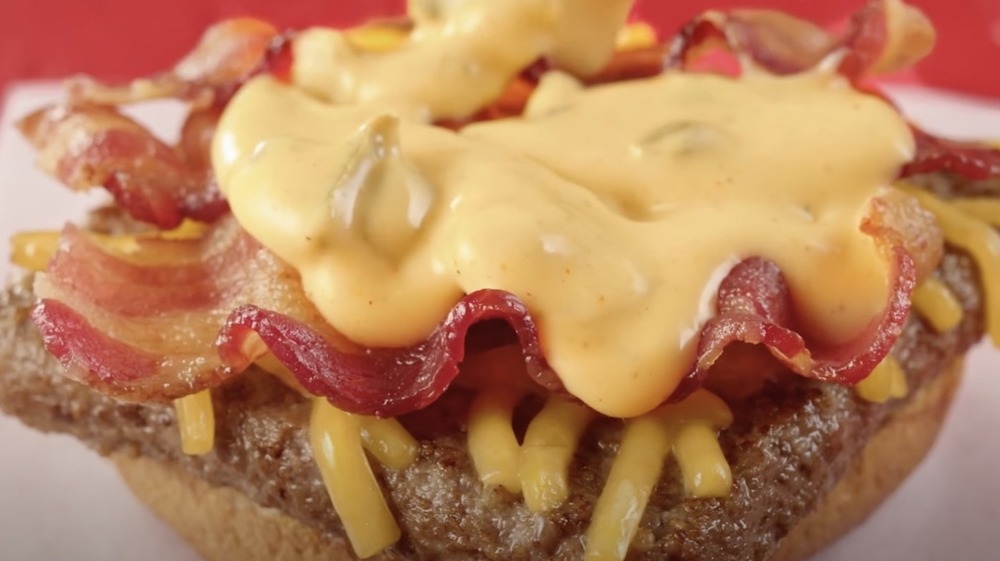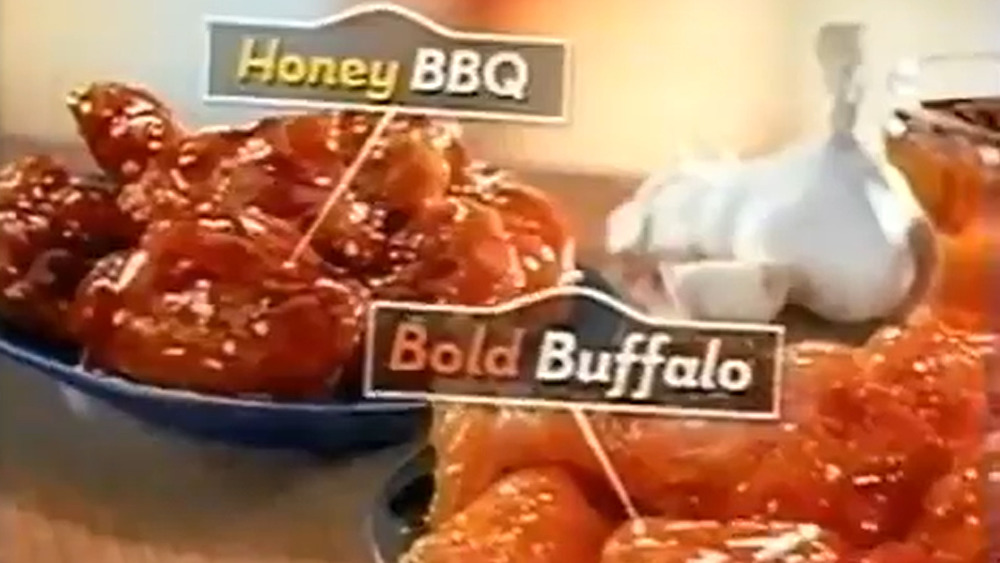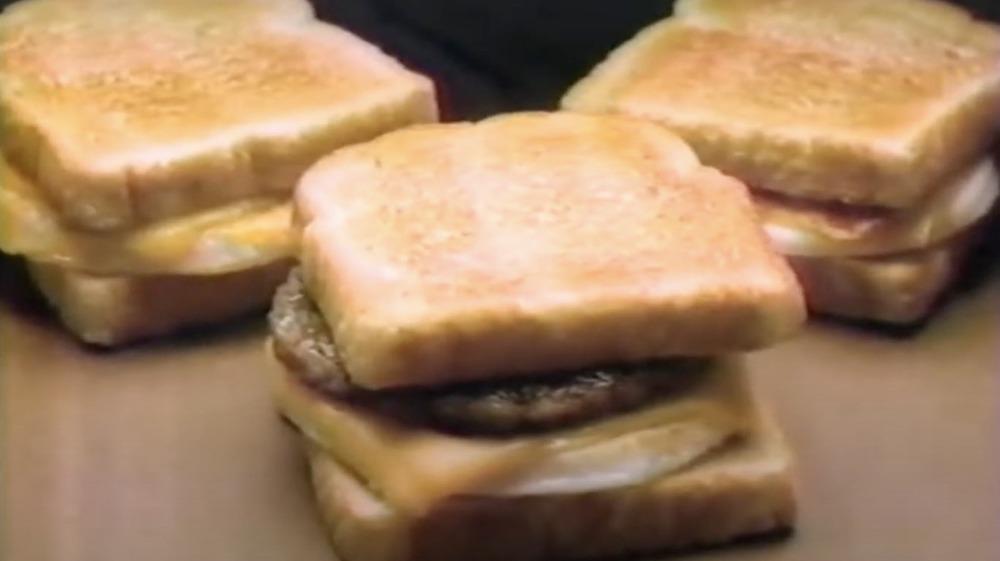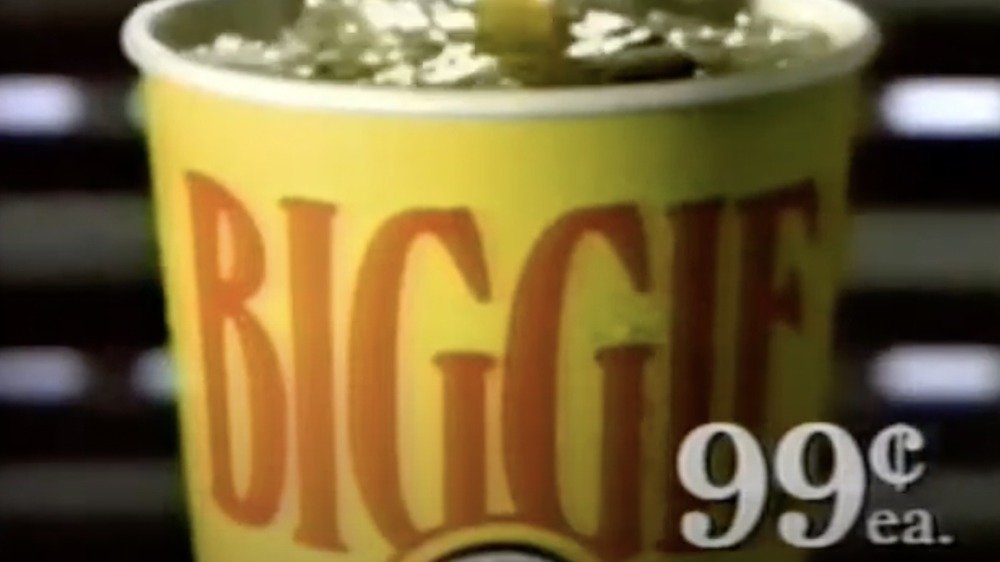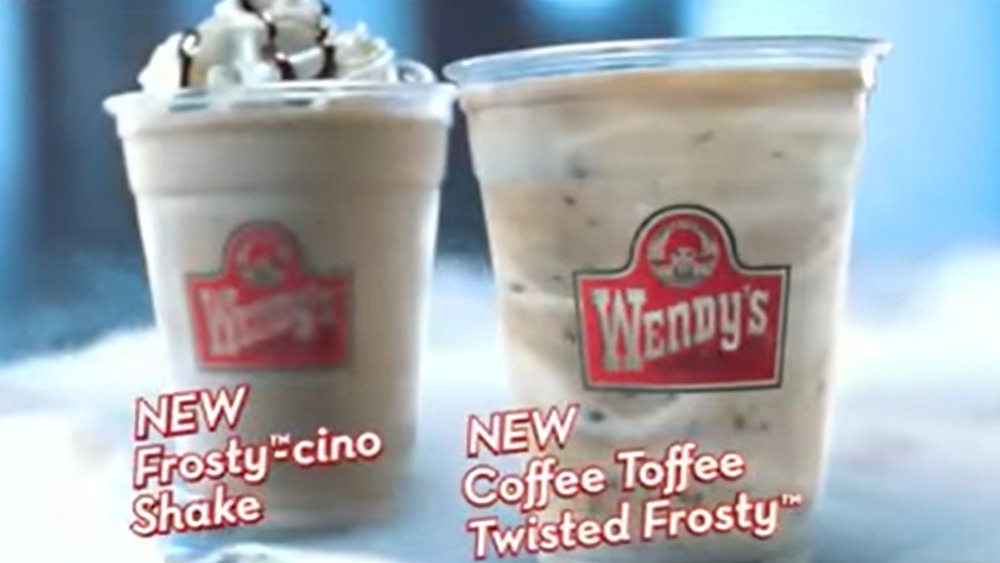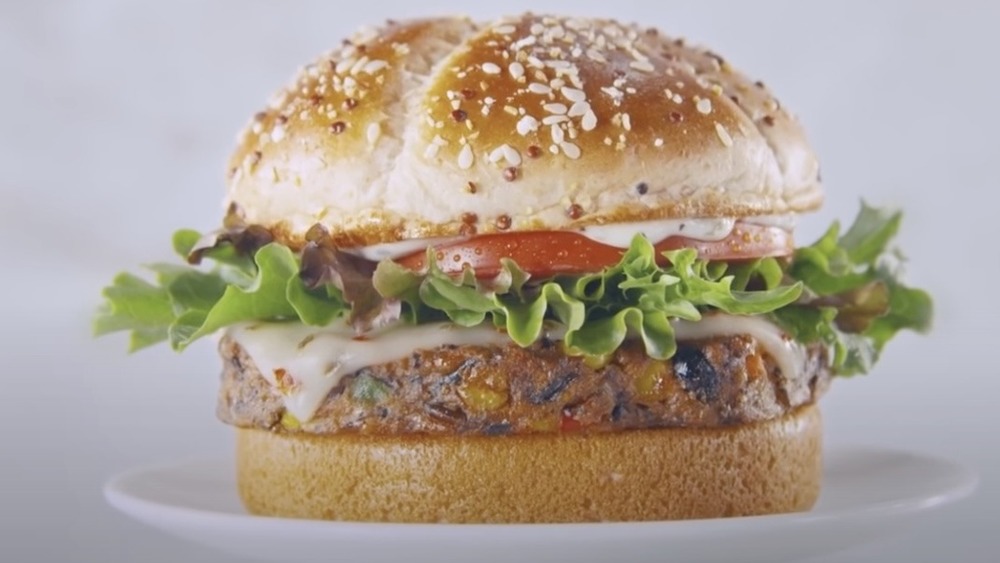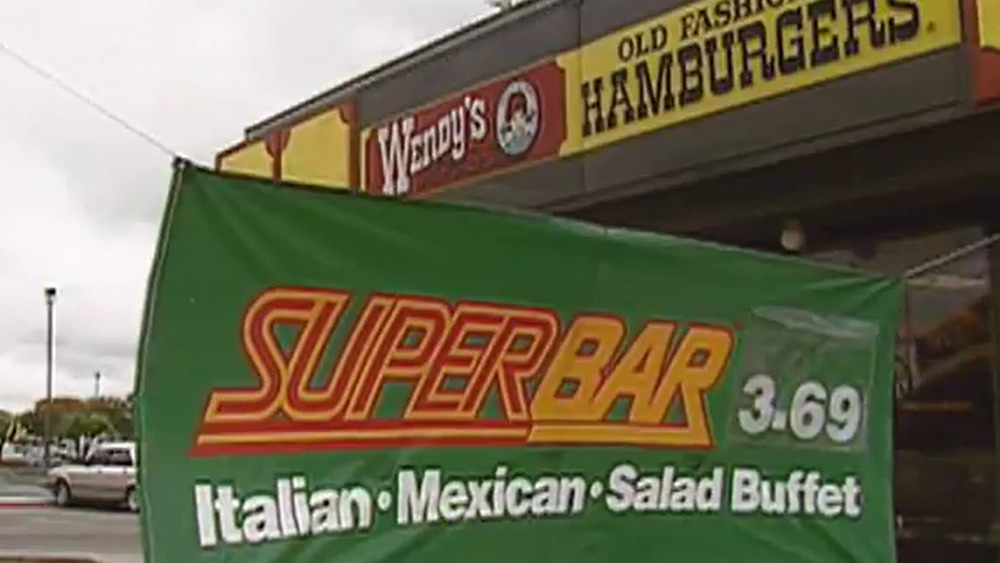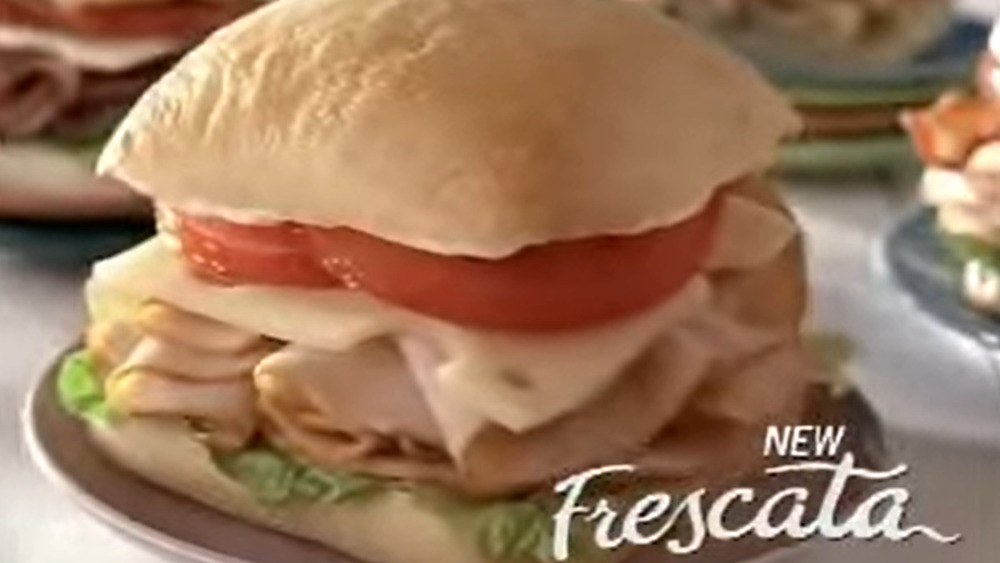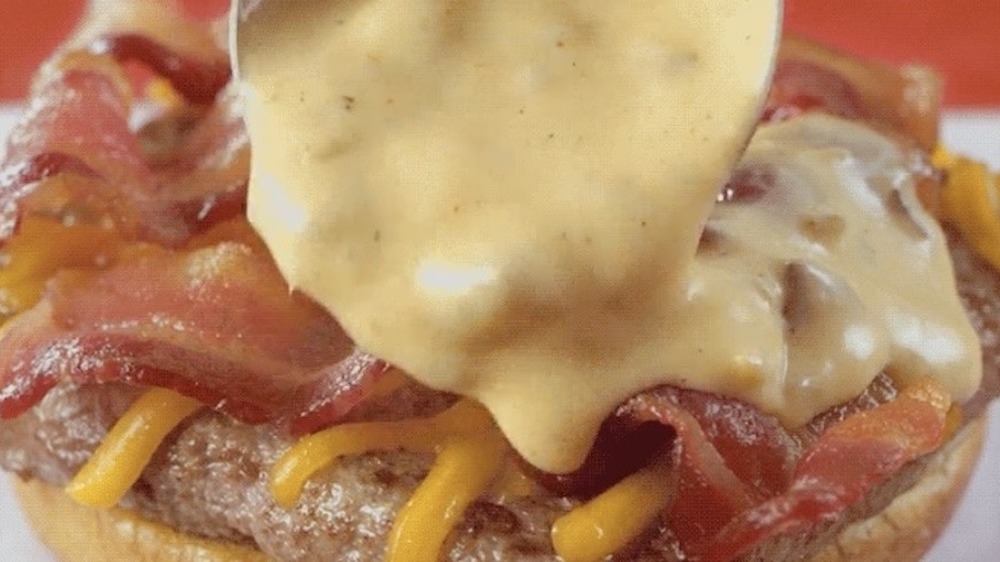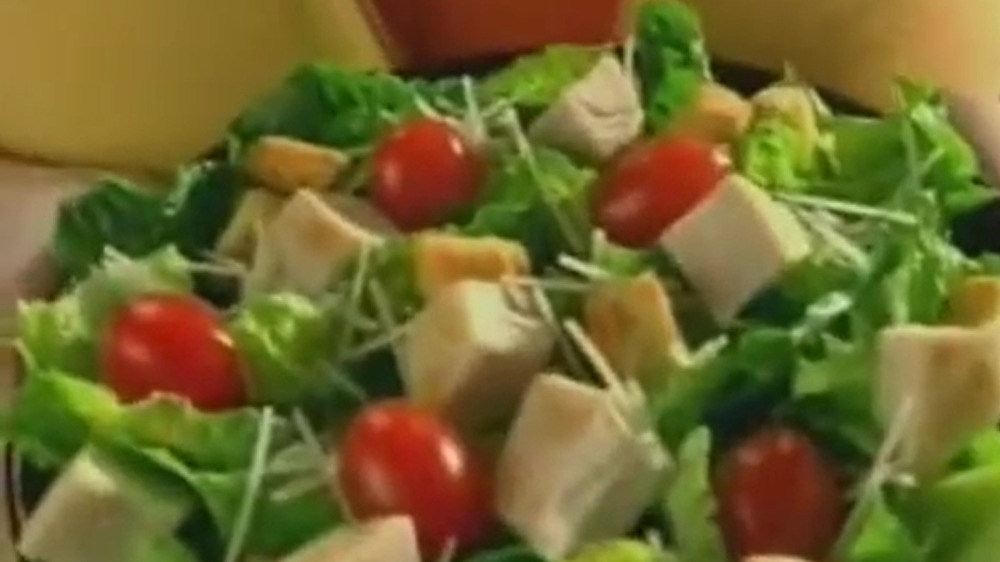Menu Items Wendy's Wishes You'd Forget About
Since modestly opening as a small Ohio restaurant in the late 1960s, Wendy's has grown to become one of the biggest fast food operations in the world. It set itself apart from its many competitors with its iconic yellow color scheme, redheaded child mascot, and square beef patties, which the company has always promised — often through ads starring Wendy's founder Dave Thomas — are fresh and never frozen. Not even counting its not-round meat, hysteria-stirring chicken nuggets, and ice cream-shake hybrid Frosty, Wendy's has always been a little bit different than the other burgers-and-fries places.
This is in part because Wendy's offers menu items that nobody else would or did, like their surprisingly well-thought-out chili and their signature baked potatoes. And, as the perpetual also-ran in the culturally and commercially dominant McDonald's vs. Burger King battle, Wendy's has sought to differentiate itself by aggressively introducing new menu items on a regular basis, thereby always getting customers to come back in to try the chain's latest unique creations. Sometimes it works, and the restaurant has a hit. But other times, it flops hard — and Wendy's would probably prefer that customers never even think about ordering one of those embarrassing, unprofitable failures again.
Wendy's briefly offered fancy chicken nuggets
Casual, sit-down restaurants offering fast food staples cut into the business of places like Wendy's, and in 2009, the chain came out swinging at the competition. That year Wendy's introduced a series of sauce-covered boneless wings — fancy chicken nuggets, in other words — like those usually found on the menu of Chili's, Applebee's, and the like. To promote them, Wendy's aired an ad mocking those restaurants, claiming them to be overpriced and selling little more than "flair," derisively evoking a phrase associated with those kinds of establishments thanks to the 1999 corporate satire Office Space.
Wendy's Boneless Wings, the first ever fast-food item of this nature according to Nation's Restaurant News, came in packs of seven to nine in the flavors Bold Buffalo, Honey BBQ, and Sweet & Spicy Asian. In contrast to its aggressive opening blow, Wendy's was left cowering when it pulled them off the menu, possibly because not enough people opted for the more expensive, sauced-up nuggets over Wendy's inexpensive, plain chicken nuggets. Seemingly not learning from this mistake, Wendy's gave fancier, restaurant-style chicken another shot in 2017 with its Chicken Tenders. According to Brand Eating, they were dropped from the menu in 2019, in part because they took a glacial-for-fast-food pace of six-and-a-half minutes to prepare.
Wendy's has tried and failed at breakfast a few times
In early March 2020, just before widespread lockdowns aimed to slow the spread of the coronavirus, Wendy's started once again released a new breakfast menu. The Wendy's A.M. menu — including the Breakfast Baconator and the Maple Bacon Chicken Croissant — proved popular, which Restaurant Business said was primarily responsible for an 8 percent rise in sales in July 2020. Wendy's would prefer to bask in the glow of that success, which proved it was competitive with breakfast juggernaut McDonald's, than have customers remember all of the other times it tried breakfast and failed.
After test marketing at a handful of locations, Wendy's widely released a breakfast menu in 1985, countering McDonald's grab-and-go Egg McMuffin sandwiches with a selection of cooked-to-order omelets and French toast with hot fruit topping (Wendy's also had egg sandwiches, but they came on toast, not English muffins). It seemed like customers didn't want knife-and-fork fare from Wendy's, and the menu section disappeared from most Wendy's outlets.
In the mid-2000s, Wendy's tried breakfast again, spurred by its acquisition of Canadian coffee-and-doughnuts chain Tim Hortons, which provided it with an in-house supply chain of breakfast items. They test marketed some items in the early aughts without a national rollout. In the 2010s the chain experimented once again with a breakfast Value Menu, which included an oatmeal cookie and the Artisan Egg Sandwich — eggs, Asiago cheese, and hollandaise sauce. Those items didn't catch on either.
Wendy's used to have "Biggie" sizes until public opinion turned
In the 1980s, Wendy's became one of the first fast food restaurant chains to offer very large portions of side items. Rather than call them something bland like "extra large," Wendy's branded the jacked-up fries and sodas with the catchy moniker "Biggie."
Ads for this new menu development primarily discussed what a value it would be for customers to buy a Biggie drink or get some Biggie fries while calling out the competition for charging too much for small cups with not enough soda and small fry boxes with just a few crispy potatoes in them. The ads made no mention of how drinking a bunch of extra sugary coke and eating a lot more fries could add hundreds more calories to an individual's daily intake, much like McDonald's similar "Super Size" options were accused of doing.
About two decades after the release of "Biggie" items, filmmaker Morgan Spurlock and his 2004 documentary Super Size Me triggered a major cultural conversation about fast food portion sizes being partially to blame for the increase in obesity and obesity-related health problems amid the population. Seeking to diminish some of the blame — if not related lawsuits — Wendy's and McDonald's quietly eliminated their Biggie and Super Size offerings, respectively. While Wendy's also switched to a less harmful fry cooking oil, it didn't actually stop selling huge sodas — a 42 ounce soda would just not be called Biggie any longer.
Customers can't get stuff in their Frosty anymore
One of the most famous Wendy's menu items is the Frosty, a blended, chocolate dessert that's thinner than a milkshake but thick enough to require a spoon. According to the blog Second Scoop Frozen News, Wendy's went all in on its singular innovation, expanding the line to include a vanilla flavor in 2006. A year later, the chain debuted the Twisted Frosty, which, like McDonald's McFlurry, blended candy and other treats into the chocolate base. Among the choices were Oreos, cookie dough, and coffee and toffee together.
By 2011, everything but the original Frosty melted away. There's some indication the sheer effort of making a complicated Frosty could have been part of the problem: According to former Wendy's employees on a Quora board, multiple flavors and types of Frosty required a lot of space in the kitchen. The original, chocolate-flavored Frostys are produced by one machine, while the vanilla one required its own separate device, as did each other flavor. Another employee also let the public know that all the fuss of extra machines and mix-ins didn't seem worth it , considering treats like the Coffee Twisted Frosty, just didn't add enough to profits.
Wendy's offered one of the first fast food meatless burgers
Wendy's would likely prefer that vegetarian customers forget that its Black Bean Burger ever existed — however briefly, and only in test markets. A meat-eschewing customer walking into a Wendy's and wanting a Black Bean Burger, only to find out they can't get one, makes for a disgruntled individual who will instead eat where vegetarian burgers are available, rather than stick around for Wendy's baked potatoes and salads.
Wendy's corporate chefs clearly put a lot of effort into making its vegetarian Black Bean Burger. First, they tested it at a few stores in Columbus, Ohio, in 2015, when the sandwich consisted of a patty made from a melange of peppers, corn, carrots, spices, and beans and came on a multigrain bun with tomatoes, salad greens (not romaine or iceberg lettuce), a specially formulated Parmesan ranch sauce, and pepper jack cheese. It got enough of a positive response that Wendy's put the Black Bean Burger on the menu at outlets in Utah and South Carolina in 2016. While Wendy's never revealed exactly why it killed the Black Bean Burger, it discontinued the sandwich just a year later.
The Wendy's Superbar was a delicious disaster
Fast food chains usually prefer that the public forgets about their fabulously failed products, whether that's because they lost money, embarrassed their company, or negatively affected perceptions by making them seem like they don't really know what their customers want. An exception to that is Wendy's Superbar — this 1988 innovation was so popular that, ironically, Wendy's had to get rid of it.
Taking a cue from the salad bar craze of the 1980s, Wendy's outlets devoted a huge portion of their indoor seating areas to a three-part, self-serve, all-you-can-eat buffet. "Pasta Pasta" included two kinds of noodles and two kinds of Italian-style sauces, "Mexican Fiesta" was more or less a make-your-own-taco station, and "Garden Spot" was a standard-issue salad bar that also housed the Superbar's dessert options: chocolate and vanilla pudding. Few other fast food outlets were doing anything like this — Burger King and Rax Roast Beef gave salad bars a try — and Wendy's made the Superbar even more attractive by offering the service for under $4 (and under $3 for kids).
Even with cheap foods like pasta, rice, beans, and iceberg lettuce on the buffet, Wendy's had a hard time making money on their Superbar with such low prices. Nor did it save costs in labor — the Superbar was so well-trafficked that employees had to constantly clean and restock the buffet areas. The buffets disappeared by 1998, and the salad bar was phased out by 2006, The Monitor reports.
Frescata sandwiches tried and failed to compete with Subway
In 2006, Wendy's unveiled a line of deli sandwiches under the name "Frescata."" They came on artisan bread and were released in four varieties: Roasted Turkey and Swiss, Black Forest Ham and Swiss, Chunky Chicken Salad, and Club. "Frescata" sounds like it could be a word in Italian or Spanish, but it actually doesn't mean anything — Wendy's invented the word to suggest "fresh," implying that the sandwiches are made with the best meats, cheese, and produce. "Fresh" could also remind customers of "Eat Fresh," a longtime slogan of the Subway sandwich chain, which by the early 2000s had made huge inroads into the market long dominated by burger joints like Wendy's, with its meat-and-cheese-loaded hoagies. In that sense, Frescata could be perceived as Wendy's strike back against Subway.
In fact, a Wendy's marketing executive at the time admitted that the Frescata sandwiches were created to make Wendy's more competitive in "the deli sandwich category, which continues to expand." But while the Frescata line was intended to generate more profit, it ultimately lost money. This might have been because the ingredients were expensive and specialized, as they were used only for the Frescata sandwiches. Plus, they also took a long time to individually prepare, and if a fast food outlet can't prepare food with fast turnaround, that's basically losing money. Frescata sandwiches lasted less than a year on the Wendy's menu.
When Wendy's poured hot cheese on everything
In 2017, the hottest thing in fast food was molten cheese. Upscale upstart Chipotle added queso to its many that year, allowing customers to add the Mexican cuisine-inspired thick-and-spicy cheese dip to their burritos or pair with tortilla chips. McDonald's soon thereafter introduced hot cheese sauce as a french fry topping, followed by Wendy's, who unveiled a whole line of queso-centric choices. The Bacon Queso Burger featured spicy cheese sauce atop a meat patty already decorated with bacon and shredded cheddar. The Bacon Chicken Sandwich did roughly the same thing, as did the Bacon Queso Fries.
From the get-go, Wendy's was clear about its queso mini-menu: It was marketed as being available for a "limited time." The company's flirtation and obsession with liquified cheese (and bacon, and shredded cheese) was but a lark, forever linked to 2017. Wendy's hasn't said much else on the matter, so most likely it doesn't want people coming in years after the fact asking for queso knowing that it cannot provide it.
Wendy's wanted customers to buy bigger salads, so it cut the small ones
Fast food restaurant value menus are an irresistible lure for millions. It's both economically reassuring and mouthwatering to know that at a number of major fast food chains, a person can fill up on a few hundred calories for just a couple of bucks. Taco Bell, McDonald's, and Wendy's are just a few of the restaurants where entrees can be had for a dollar or two, with the latter offering hamburgers and chicken nuggets as well as lighter choices like wraps and side salads. But that value menu can be a double-edged sword for fast food companies.
Sure, it gets people into the store or the drive-through lane, but cheap foods for the customer could mean meager to negligible profit margins for the restaurant. Wendy's, like any other food company, would prefer that customers order more expensive and profitable items, like its big sandwiches and large, entree-sized salads, because those net the restaurants more cash.
In 2020, Wendy's eliminated some items from its low-cost value menu. According to one former employee on a Wendy's Reddit thread, the side salad, Caesar side salad, and wraps all got the boot. Wendy's CEO Todd Penegor told Columbus Business First that the salads didn't sell very well to begin with. Salads in particular are also pre-made, so any unsold ones get thrown out, making them a money loser for Wendy's.
